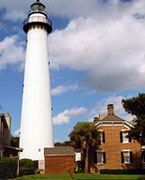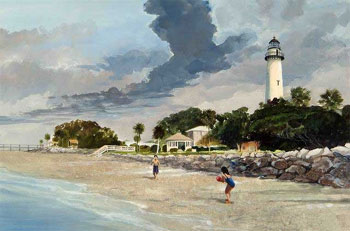


























|
 St. Simons Lighthouse Painting by Roger Bansemer
St. Simons Lighthouse Painting by Roger Bansemer |
On October 17, 1804, John Couper, a plantation owner on St. Simons Island, deeded four acres of his land, known as "Couper's Point," at the south end of the island for $1 to the Feds for the construction of a lighthouse. |
In 1807, James Gould of Massachusetts was hired by the Treasury Department to build the lighthouse and a one-story frame residence.
Original specifications called for the lighthouse to be built of hard brick; however, for economic purposes, most of the material used in the construction was "tabby," a mixture of oyster shell, lime, sand, and water. The uppermost part (12_ feet) was constructed of the "best northward brick." The 75-foot tower, exclusive of the lantern, was an octagonal pyramid, 25 feet in diameter at the base, tapering to 10 feet in diameter at the top. The tabby foundation was eight feet thick at the base. An iron lantern ten feet high and eight feet in diameter rested on top of the brick and tabby tower, making the lighthouse 85 feet tall. Oil lamps were suspended on iron chains in the lantern.
Appointed in May 1810 by President Madison as the first keeper, James Gould held this position at an annual salary of $400 until his 1837 retirement. |
 In 1857, a third-order, double-convex Fresnel lens was installed that greatly improved the lighthouse's power and range. During the Civil War, the Macon Artillery troops and six field guns were stationed at Fort Brown to protect St. Simons Sound. In 1857, a third-order, double-convex Fresnel lens was installed that greatly improved the lighthouse's power and range. During the Civil War, the Macon Artillery troops and six field guns were stationed at Fort Brown to protect St. Simons Sound.
In February 1861, Alexander Couper, son of John Couper, wrote to his brother, James, "I went down to the Island to the officers at 'Fort Brown'--they are comfortably situated in thatched camps. They have built two angles of eighteen-feet base as a breast work. The Fort lies just west of the lighthouse in a corner of Mr. King's field." (The Kings were the owners of Retreat Plantation, now the Sea Island Golf Club and Lodge)
During the Civil War, the blockade of Federal ships and the subsequent invasion of Georgia by Federal troops forced the Confederates to evacuate St. Simons Island.
Prior to leaving in 1862, the Confederates destroyed Gould's lighthouse so the Federal forces could not use it as a navigational aid. |
|
For the next ten years, Retreat Plantation's cotton barn served as a navigational reference for ships entering Brunswick harbor. The tall cotton barn was marked on U.S. government maps as "King's Cotton House."
The ruins of the first lighthouse were partially excavated by archaeologists during August 1974. Its boundaries are just south of the oil house where one can see a mound of grass. A photograph and history are explained on an interpretative sign at that spot. James Gould probably built a frame house to serve as the home for the lighthouse keeper and his family. The exact site of that dwelling is not known. |
The Second Lighthouse and Keeper's Dwelling (1872)
The U. S. Government ordered the construction of a second lighthouse that was placed west of the first. The 104-foot tower, which has a 129-step cast iron spiral staircase and an adjacent keeper's house, were designed by one of Georgia's most noted architects, Charles Cluskey.
Cluskey (1805-1871) was one of the most important architects of this period. A native of Ireland, Cluskey worked in Georgia between 1830 and 1847 designing Greek Revival buildings. Later, he served as a consultant in Washington, assisting with renovations of public buildings such as the Capitol. Sent to build a lighthouse on St. Simons Island, Cluskey and some of the crew never saw the fruition of their effort, dying in 1871 of malaria, a year before the structures were completed. Official records of the lighthouse keeper stated in 1874: "This station is very unhealthy, and it is attributed to the stagnant water in several ponds in the vicinity." |
In 1876 the U. S. Lighthouse Establishment performed a "thorough overhauling" at the lighthouse; workers weather-proofed the roof and walls of the dwelling and installed a speaking tube which ran from the watch room in the tower to the house.
The U.S. Lighthouse Establishment household had to be self-sufficient except for basic lighthouse supplies such as fuel, paint, ropes, and lighthouse maintenance equipment. The keeper and his assistant shared the dwelling, the keeper's family living downstairs and the assistant's upstairs. A central stairway connected the two households. A tower room connected the keeper's dwelling to the tower. Tempers flared one Sunday morning in March 1880 between the head keeper and his assistant. The argument left the keeper, Frederick Osborne, dead. Legend claims that his footsteps in the tower have been heard by the wives of later keepers. |
|
In 1890, a fire-proof brick oil house was constructed beside the lighthouse. This 9' x 11' building could hold 450 five-gallon oil cans. The lighthouse kerosene lamp was replaced by electricity in 1934. On June 1, 1939, the lighthouse was placed under the jurisdiction of the U.S. Coast Guard. Twenty years later, the lighthouse was fully automated with timers to turn the light off and on. The third order Fresnel lens projects the beam eighteen miles. It is operated by one 1,000 watt mogul lamp rotating to produce one beam per minute.
The lighthouse keeper's dwelling (1872) is a unique Victorian design. Architectural details not only enhance the beauty of the structure but draw the eye upward to the tower to the tower. Window moldings and acanthus leaf brackets are of cast iron. It is a solid, sturdy structure built of Savannah gray brick. The walls are twelve inches thick. The heart pine floors are original. Around 1910, when Carl Olaf Svendsen was head lighthouse keeper, the dwelling was altered into two apartments by removing the central staircase. An exterior staircase, stoop, and door were added on the north side giving access to the second floor. These steps and stoop were removed, the doorway re-bricked, and the central stairway rebuilt during the 1975 rehabilitation. |
 The lighthouse keeper's house served as a home for the lighthouse keepers from 1872 until 1950 when, following the complete automation of the lighthouse in 1953, the last lighthouse keeper, David O'Hagan, retired, and the passageway was taken down to separate the lighthouse from the keeper's house. The lighthouse keeper's house served as a home for the lighthouse keepers from 1872 until 1950 when, following the complete automation of the lighthouse in 1953, the last lighthouse keeper, David O'Hagan, retired, and the passageway was taken down to separate the lighthouse from the keeper's house.
The U.S. Government then began using the dwelling as office space. It was given in 1960 to the Bureau of Commercial Fisheries, Department of the Interior, Fish and Wildlife Service. In 2004, the lighthouse was deeded to the Coastal Georgia Historical Society under the Lighthouse Preservation Act after a long a successful lease arrangement with the U.S. Coast Guard and the Society. Today, with the assistance of the U.S. Coast Guard Auxiliary, the light continues as an Aid to Navigation, shining seaward every night and during inclement weather.
Other facilities are a museum and gift shop. A small fee is charged for admission. |
| Contact and Address |
| Phone: 912-638-4666 - Address: St. Simons Island, Georgia 31522 Directions: From Brunswick, cross F. J. Torras Causeway. Go right on Kings Way to Ocean Boulevard. At Mallery St, continue to 12th St. Turn right and proceed to lighthouse and museum. |
|
|
Check These Out:
 NPS Coast and Islands NPS Coast and Islands
 GA Coast and Islands GA Coast and Islands
 Georgia Coast Events Georgia Coast Events
 Coast Free Things To Do Coast Free Things To Do
 GA Coast Fishing Lakes GA Coast Fishing Lakes
 Georgia Coast Museums Georgia Coast Museums
 Georgia Coast Shopping Georgia Coast Shopping
 GA Coast and Islands Map & Travel Region GA Coast and Islands Map & Travel Region
|








